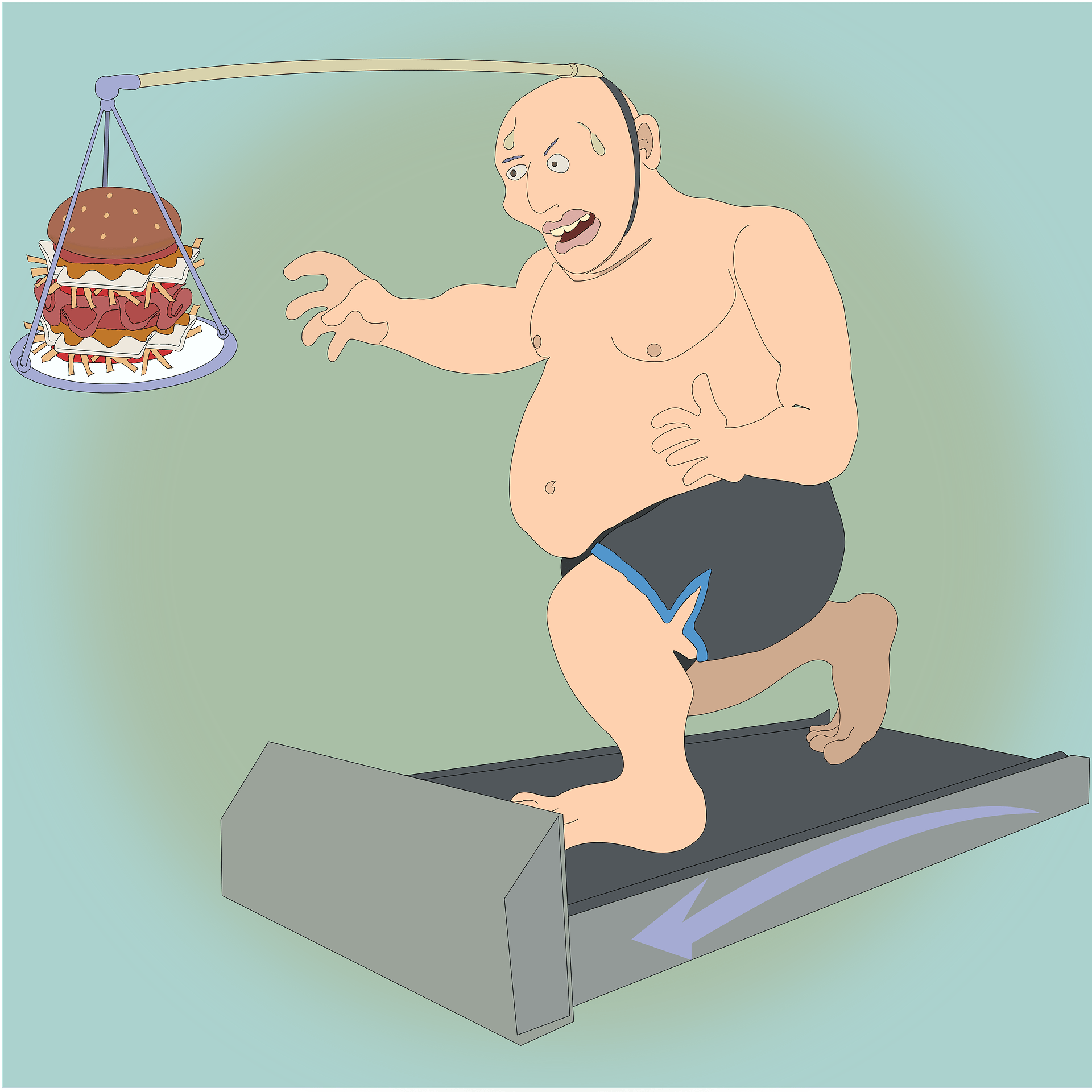Obese, big-boned, overweight, fat, portly–you name it, I’ve been it, having spent the majority of my adult life over 200 lbs and at one point tripping the light not-so-fantastic at over 260. I’ve managed to get things out of the ludicrous zone, and spent most of the last decade in more of the “dad bod” 220-range, carrying around a 30-day “survival pack” of pure, unadulterated lard.
During these years of being less-than-slim I’ve tried various diets, ranging from Atkins, which was effective but unsustainable and has now seemingly rebranded and reincarnated itself as “Keto,” to calorie tracking, the Zone, Mediterrain diets, and all manner of other stuff. The two primary conculsions I’ve reached are:
- The fundamental key to weight loss is that you need to burn more calories than you consume. Everything else is icing on the cake. Whether it’s Keto, Caveman, Vegan, or Voodoo, the only way any of these things result in fat loss is that you have a calorie deficit so your body is force to metabolize “onboard” calories in the form of some combination of sugar stores, body fat, and muscle. Any diet that works isn’t due to the proprietary anti-oxidant ultra-cleansing free radical ketones, it’s due to the fact that you ate less calories than your body needed (or you just got a bottle of fancy laxatives and diuretics that made you poop and get dehydrated, resulting in dramatic, albeit strictly temporary weight loss).
- For me, it needs to be easy. I could never stick with things like Atkins/Keto, Zone, or Veganism since I’m not a “food racist.” I love all kinds of foods and am not willing to sign on to a lifetime of discrimination against any of them, even that source of all evil and oppression: whitey (aka refined white sugar).
I’ve had decent success with good old fashion calorie tracking, and tools like MyFitnessPal make this somewhat easy, although I ultimately “fall off the wagon” through a gradual process of forgetting to log, or not wanting to whip out my phone when dining out. These minor slips don’t seem like much at the time, but consider that an extra 150 calories over your daily needs, which is a mere two Oreo cookies, is 4,500 extra calories per month, which your body will happily store as 1.5 lbs of fat. In six months, you’ll have quietly added 6 lbs of girth, and in a year a “stealth 12 lbs.” Double that to the equivalent of 4 Oreos, a good handful of Almonds, or a couple beers, and you’re tacking on about 25 lbs. each year. Ouch.
Enter Fasting
Fasting isn’t a particularly new idea, in fact most thousand-plus year old religions espouse some form of fasting, and it’s caveman (or water buffalo)-grade simple. Don’t eat for some defined period of time, and you’ll natually run a calorie deficit since you simply don’t have time to pack in all those extra Oreos and beers (it’s a less gross combination than it sounds, beleive me, I’ve tried it).
Since fasting has become “hip,” there’s all manner of new research, and like any on-trend diet or lifestyle some seemingly outrageous claims. With all diets I take the bold claims (FasTING cUReS CanCER!!!!!, etc.) with a bag of salt, and look for any significant averse effects as well as “sanity check” the diet. For example, eating tons of meat, bacon, and caesar salads with Atkins never quite seemed right despite positive results, but fasting definitely passes the “sanity check.” Many of the purported benefits derive from my vastly oversimplified distilling of complex science to the fact that not eating for a while gives your digestive system a break, and let’s your body “take out the metabolic trash.” No one dies from normal fasting, and our bodies can go for weeks without food so a matter of hours doesn’t seem like a health risk.
The Approach
Staying true to my desire to adopt a massively simplified and sustainable approach to eating, I tried a 16/8 fast. It’s the easiest diet ever to explain: don’t eat for 16 hours, and eat for 8. The 8 hour window most recomended, and that I’ve been following is noon to 8PM. This allows you to operate in society fairly normally, and also prevents you from eating too close to bedtime, which pretty much everyone strongly discourages.
There are days I’ll stray 30 minutes or so in either direction, so I started with a phone app (there are several, I used Zero) to stay true to my 16 hours of not eating, and ultimately switched to a wideget on my beloved Garmin watch as it’s a bit less obtrusive at the dinner table.
Black coffee, which I prefer anyway, is allowed since it’s essentially zero calorie, so I wake up, have my cuppa, get in a workout, and then cruise until lunchtime. I done up to 60 minute runs, and was also fasting during my GAP/C&O ride which generally invovled 2-3 hours of low-intensity cycling before lunchtime. I did consciously break my routine before a higher-intensity 60-mile bike ride for fear of bonking, and am going to test my ability to run longer while fasted as I start training for my next 50K.
The Results
I’ll start with the chart and let that speak for itself. I started my fasting program on 8/25 at 223.1lbs, so there are a couple weeks of data pre-fast included for reference.

I maintained approximately the same level of physical activity (about 6 hours/week of cardio) save for the week of 9/30-10/6 where I was on my GAP ride and you see the rather straight section of graph due to no weight logging. I ate rather heavily during that trip, so you’ll see the interesting bump and then rapid drop in weight.
I’m not smart enough to add a moving average line to the graph, but it’s pretty obvious that it’s gone consistently down and I’m within spitting distance of 200 lbs, a weight I haven’t called my own since high school.
Pros
- Positive results. I’ve averaged 1-2 lbs per week of loss which is in the healthy range for adults.
- It’s dead simple. Don’t eat from 8PM to Noon. Period. Full stop. This is perhaps the biggest selling point for me. No counting of anything, no “off limits” foods, no complex ratios. I’ve tried to eat in a more healthy manner, but had a few whiskey or pizza nights or whatnot, but have maintained the 16 hour fast without regret or lament.
- The simplicity corrects some bad behaviors on my part, mainly the 10AM “snackies” where I’d camp in the panty and munch mindlessly while on a call or thinking through a work problem. This is where those “stealth” pounds originate.
- I feel fine. My first couple workouts felt a bit off, and really high intensity stuff for more than 60 minutes can be challenging, but on the whole there’s enough sugar stores from finishing eating at 8PM that you’re able to do normal physical activity. When I feel “off” in the morning it’s usually cured with a cup of black coffee and a salt pill/electrolyte tablet.
- This feels sustainable regardless of whether I’m travelling or at home, or anywhere in the world.
- You get some time back in the morning. I make breakfast for the kids during the week when I’m home, but on the weekend I’ll read or work on something while the family eats breakfast.
- Presumably your individual food costs drop by a third, but I haven’t tracked or validated that since it’s not a big factor for me.
Cons
- I like breakfast, both the ritual and the food. I’ve mitigated this with one big brunch at noon rife with pancakes and all that stuff.
- I’ve had probably 4 days of the 60 where I’m ready to start gnawing my desk around 11AM, however the brainless simplicity of “don’t eat until noon” makes the objective clear, and worst case I’ll have a giant glass of water or a coffee if I’m totally dying.
- Breakfast is a long-running tradition in most circles, so you’ll get some weird looks from family. I haven’t been fasting at work since I’ve been 100% working from home, but I would imagine I’ll get an odd look or comment when I skip breakfast with colleagues.
- The 8PM cutoff is tough sometimes, and I suspect will get more challenging when I’m back to travelling and work dinners occasionally don’t even start until 8PM. I’m not sure if I’ll mitigate that by extending my eating start the next day, or just calling it a “lost day.”
So, What’s Next
I’m willing to deem my 60-day trial an unmitigated success, and will continue with the 16/8 fasting. My goal weight is just below the official BMI threshold for “overweight” of 195 lbs. I beleive rather firmly in the body’s ability to adapt and to signal what it needs, some of us (like me) just struggle sometimes to listen to those signals. I’ll continue the 16/8 even after hitting my goal unless I experience any averse effects.
My only medium-sized concern at this point is accomidating an increase in long endurance runs as I prepare for some long-distance trail runs. I may do a “non fasting” day once or twice a week to accomidate. There’s some emerging science about becoming “fat adapted” and using all kinds of fancy non-carbohydrate based foods to run or cycle, but I’m on the old fashioned side of the house and will stick with the theory that your body can store about ~1,000 calories of blood sugar-based energy, so once my runs are exeeding that burn I’ll monitor my performance and add additional calories through standbys like energy drinks and fig bars.
I’ll attempt to remember to add a 6-month update, which should give me adequate time to hit my goal weight and have more data on the effects of longer-duration endurance activities, but until then, don’t invite me to breakfast (although I will be a cheap date).



0 Comments